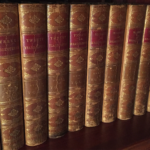The Bookshelf has been on a heavy diet so far this year—hermeneutics, postliberalism’s left-wing roots, anti-Semitism, dystopias—so I thought it was time to lighten up my reading. Over the last month, therefore, I’ve read works by Hawthorne, Melville, Henry James, Hemingway, Faulkner, Turgenev, Tolstoy, Joyce, Somerset Maugham, Evelyn Waugh, Flannery O’Connor, and Muriel Spark. For good measure, I threw in some Edgar Allan Poe, Ian Fleming, Robert A. Heinlein, and G. K. Chesterton.
I am sure you have guessed that what I have been doing is reading short stories and novellas. I saw a news story somewhere recently to the effect that, owing to the damage done to young people’s attention spans by their smartphones and social media, high school English teachers are eschewing the assignment of novels to their classes, opting for short fiction instead. (My own attention span must be similarly harmed, since I cannot recall where I read this and did not bookmark it.) Now I was in high school a half century ago, and I do not recall being asked to read many novels. I think this attention span problem is not a new thing; it is probably part of the package called adolescence. If it is worse today—and I don’t doubt it is—then it is appropriate to deal with newer threats to sustained attention and thinking. But the fundamental threat might be called Being Fifteen (or Twenty).
And short fiction definitely has its virtues—not just pedagogical ones. Calliope, the muse of epic poetry, may have inspired Homer and Virgil to compose their grand narratives at lengths like those of modern novels. But probably the oldest form of storytelling was the tale that could be told from beginning to end of an evening around the campfire. The individual tales condensed into a more continuous mythology by Hesiod’s Theogony may have been of this sort originally, as might the individual episodes in Ovid’s Metamorphoses. And a more homely kind of tale, suitable for children, can be seen in the Fables attributed to Aesop. The fairy tales produced by folk cultures and embellished by modern compilers like Joseph Jacobs, the Brothers Grimm, and Hans Christian Andersen similarly represent centuries-old storytelling traditions, as do the tales of the Arabian Nights. I daresay every one of us is familiar with at least one of the tales told in each of these old books. We have all “heard tell of” Prometheus, and Narcissus, and of the Hare and the Tortoise; of Jack the Giant-Killer, and Hansel and Gretel; of the Little Mermaid, and the adventures of Sindbad the Sailor.
There is something morally edifying about fables and fairy tales, as there is about the tales collected in the popular medieval Gesta Romanorum. Not so Boccaccio’s Decameron, a collection of stories that proved a rich mine for Chaucer and Shakespeare, among many others. Bawdy comedy and earthy adventure, with not a little impiety, is Boccaccio’s metier. One might call his stories “adult content fairy tales.” But the delight is not in their erotic or scandalous quality; it lies in the charming wit of their telling. They are entertainments.
Start your day with Public Discourse
Sign up and get our daily essays sent straight to your inbox.I am no historian of literature, but I do not think that short fiction as we know it today is coeval with the emergence of the modern novel since, say, Cervantes. It is a later development. The printing press revolutionized literature, as it did every other field of thought, along with the spread of literacy, and the gradual settling of sophisticated standard usage in vernacular languages. Printers moved in two directions, toward the short and the long: brief newspapers and broadsides, with the occasional pamphlet, on the short side, and books (including novels) on the long side. Even early “periodicals” such as the Tatler and the Rambler in eighteenth-century England were essentially small newspapers produced once or twice a week.
It was not until the nineteenth century that printing technology (and the manufacture of paper from wood pulp) improved enough to create periodicals of substantial length appearing biweekly, monthly, quarterly, what have you. Editors need content, and these magazines became the home of the long-form essay in nonfiction and the short story in fiction. The dawn of a real magazine culture was the morning in which the modern short story took the form we know.
Practically all the short stories of the last two centuries that we read in authors’ collections or anthologies had their first appearances in magazines. Nathaniel Hawthorne’s “The Birth-mark” (found here) was published in 1843 in The Pioneer, a Boston magazine. Herman Melville’s “Bartleby the Scrivener” appeared in two successive issues of Putnam’s magazine in 1853. Henry James’s “Daisy Miller” was published in two issues of Britain’s The Cornhill Magazine in 1878. And so on.
The magazines of the nineteenth century also published novels in serial installments prior to their publication as books, including works by Dickens and Dumas among others. Serial novels fell out of favor in the twentieth century. But it is interesting how many of the writers we recognize as great modern novelists also wrote short stories and novellas for the periodical press. In some cases they got their start this way. Muriel Spark tells of entering a contest for a newspaper Christmas story, her winning entry being “The Seraph and the Zambezi” (available here) for which she was paid £250 (a nice prize in 1951) and considered herself launched as a writer.
In some cases writers were equally adept and comfortable in both forms, like painters equally at ease with large canvases thickly peopled, and with miniature portraits as well. The Tolstoy who could produce War and Peace and Anna Karenina could also precisely cut a small jewel like “Master and Man.” Sometimes the shorter form allowed an author to try a little experimentation. Perhaps the most unusual James Bond story was Ian Fleming’s 1959 “Quantum of Solace” (the recent movie had nothing in common but the title), which is not really a Bond story at all, and was first published in Cosmopolitan. For a veritable writing machine like P. G. Wodehouse, the availability of magazine publication for his short stories (later collected into books and thus sold twice to the public) was probably as important as his regular production of novels.
And in the thriving magazine culture of the nineteenth and early twentieth centuries, the opportunities abounded for periodical publication. Harper’s, McCall’s, Collier’s, Vanity Fair, The Saturday Evening Post, The Century Magazine—the list of magazines publishing short fiction was very long. The market was large, the circulations were wide, and the money was often very good. Many of the general-interest magazines of the era are gone now, and those that remain rarely publish much fiction, if any.
It’s rather a shame, really. Many families took at least one of these magazines, which exposed them to some of the most notable writers of the twentieth century in brief compass—Faulkner’s “Barn Burning” in Harper’s, Hemingway’s “The Killers” in Scribner’s Magazine. Nowadays almost no one gets short fiction arriving in the mailbox on a regular basis. Our consumption of entertainment is of an altogether different kind; those magazines didn’t survive because the market for them dried up.
While the magazine culture lasted—including the lower end of the market represented by the cheap “pulp” magazines—whole new genres of fiction were invented there. Detective mysteries, launched by Poe’s C. Auguste Dupin solving “The Murders in the Rue Morgue,” then advanced by Arthur Conan Doyle’s sublime genius Sherlock Holmes in the Strand magazine, and by G. K. Chesterton’s Father Brown in magazines on both sides of the Atlantic, were a fully established genre of storytelling before Agatha Christie ever got started. Modern science fiction took a quantum leap beyond Verne, Wells, and Burroughs in the pages of John W. Campbell, Jr.’s Astounding Science Fiction, which featured writers soon to be famous such as Isaac Asimov, Robert A. Heinlein, Jack Williamson, and Lester Del Rey.
Hollywood, too, benefited from a constant churn of new short fiction in magazines and reached back to earlier material as well. Shorter novels, for obvious reasons, are easier than long and complex ones to adapt into screenplays, and novellas and short stories are easier still. Hollywood producers bought the rights to them by the barrelful. Hemingway’s “The Killers,” a very short tale, was embellished into a magnificent film noir with Burt Lancaster and Ava Gardner in 1946. Howard Hawks’s 1948 Red River was based on a serialized novella in The Saturday Evening Post titled “The Chisholm Trail.” James Hilton’s novella “Good-Bye, Mr. Chips!” was spread over twenty-five pages of the April 1934 Atlantic Monthly and was snapped up to become one of the most successful films of the banner year of 1939. W. Somerset Maugham’s “The Letter” was adapted into one of Bette Davis’s most memorable vehicles. And Ridley Scott’s first feature film (still one of his best, I think) was The Duellists (1977), based on Joseph Conrad’s “The Duel,” a novella serialized in Britain’s The Pall Mall Magazine in 1908.
Some short genre fiction survives in small magazines dedicated to mysteries and science fiction, but the monthly general interest magazine featuring fiction alongside journalism, commentary, and reviews is essentially dead. (Does any such magazine other than Harper’s regularly publish any fiction at all?) Even poetry, that poor stepchild of the publishing world, makes more regular appearances in contemporary magazines. Our literary culture suffers, I think, from a lack of mainstream outlets for short fiction reaching the general public. Certainly writing for film and television is poorer for the lack of good adaptable material of this kind. And if short stories are the wardrobe through which young people can pass into a world where they learn to appreciate novels as well, then the demise of magazine fiction is truly unfortunate. Let those teachers assign lots of classic short fiction. The taste of the young is developed in small helpings.
Image by Ivan Kurmyshov and licensed via Adobe Stock.














